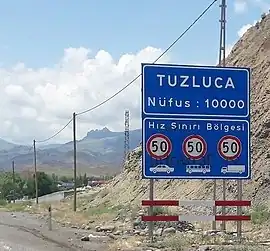Tuzluca
Tuzluca (Azerbaijani: Duzluca; Kurdish: Qulp;[2] Armenian: Կողբ Koghb; Russian: Кульп or Тузлуджа) is a town in the Iğdır Province in the Eastern Anatolia region of Turkey. It is the seat of Tuzluca District.[3] Its population is 9,619 (2022).[1] It lies near the border with Armenia.
Tuzluca | |
|---|---|
 | |
 Tuzluca Location in Turkey | |
| Coordinates: 40°02′58″N 43°39′39″E | |
| Country | Turkey |
| Province | Iğdır |
| District | Tuzluca |
| Government | |
| • Mayor | Ahmet Sait Sadrettin Türkan (AKP) |
| Elevation | 870 m (2,850 ft) |
| Population (2022)[1] | 9,619 |
| Time zone | TRT (UTC+3) |
| Postal code | 76900 |
| Area code | 0476 |
| Website | www |
Etymology
Tuz means salt in the Turkish language. The Turkish name Tuzluca is derived from the salt mines that have existed here since at least medieval times; a salt mine still operates.
History
Known by Armenians as Koghb, Tuzluca was historically part of various Armenian kingdoms. The town and the surrounding area later became an Ottoman frontier Kurdish chiefdom and a scene of constant warfare between the Ottoman Empire and Persia. It was especially renowned for its salt mines.
In 1746, the region was finally ceded to Persia and became part of the Erivan Khanate. After the Russo-Persian War, 1826–1828 and Treaty of Turkmenchay, it passed from Persian to Russian control. Under Russian rule, the town, now known as Kulp, became part of the Surmali district of the Armenian Oblast and later the Erivan Governorate. In 1829, shortly after the Russian annexation, Baltic German explorer Friedrich Parrot of the University of Dorpat (Tartu) travelled to Surmali as part of his expedition to climb Mount Ararat. Two members of Parrot's expeditionary team, medical students Carl Schiemann and Maximilian Behaghel von Adlerskron, travelled to Kulp with four Cossacks to examine the salt mines.[4]
After the Russian Revolution, the town came under the administration of the Democratic Republic of Armenia. However, it was ceded to Turkey by the Soviet Union in the Treaty of Kars.[5] It was traditionally part of Kars province until the creation of predominantly Iğdır province in 1993. Today, Tuzluca serves as a highland retreat for asthma patients. Apricots and other fruit and vegetables are grown in the district.
Government
In the local elections in March 2019 Ahmet Sair Sadrettin Türkan was elected mayor.[6]
Population
The town has a mixed population of Azerbaijanis and Kurds.[7]
| Year | Pop. | ±% p.a. |
|---|---|---|
| 1980 | 6,911 | — |
| 1985 | 8,104 | +3.24% |
| 1990 | 7,698 | −1.02% |
| 1997 | 10,652 | +4.75% |
| 2007 | 11,239 | +0.54% |
| 2012 | 9,177 | −3.97% |
| 2017 | 9,922 | +1.57% |
| 2022 | 9,619 | −0.62% |
| Source: Population censuses (1980-1997)[8][9][10][11] and TÜIK (2007-2022)[1] | ||
Notable people
- Eznik of Kolb, writer (5th century)
- Mehmet Hakkı Suçin, Arabist and translation scholar
- Servet Çetin, soccer player
- Şamil Ayrım, member of the Grand National Assembly of Turkey[12]
References
- "Population Of Municipalities, Villages And Quarters". TÜIK. Retrieved 24 March 2023.
- İbrahim Sediyani (2009). Adını arayan coğrafya. Özedönüş Yayınları. p. 187. ISBN 9786054296002.
- İlçe Belediyesi, Turkey Civil Administration Departments Inventory. Retrieved 1 March 2023.
- Parrot, Friedrich (2016) [1846]. Journey to Ararat. Translated by William Desborough Cooley. Introduction by Pietro A. Shakarian. London: Gomidas Institute. pp. 160–164. ISBN 978-1909382244.
- Parrot, p. xxix.
- Şafak, Yeni (2019-12-19). "Iğdır Tuzluca Seçim Sonuçları – Tuzluca Yerel Seçim Sonuçları". Yeni Şafak (in Turkish). Retrieved 2019-12-19.
- "Tuzluca yerleşimleri". nisanyanmap.com. NişanyanYeradları. Retrieved 29 January 2021.
- "1980 General Census" (PDF) (in Turkish). Turkish Statistical Institute. 1980. Archived (PDF) from the original on 17 June 2022.
- "1985 General Census" (PDF) (in Turkish). Turkish Statistical Institute. 1986. Archived (PDF) from the original on 22 May 2021.
- "1990 General Census" (PDF) (in Turkish). Turkish Statistical Institute. 1991. Archived (PDF) from the original on 31 August 2021.
- "1997 Population Count" (PDF) (in Turkish). Turkish Statistical Institute. 1999. Archived (PDF) from the original on 30 October 2022.
- https://www.tbmm.gov.tr/milletvekili/milletvekilidetay?DonemId=f72877c2-f508-037b-e050-007f01005610&Id=f72877c2-dc44-037b-e050-007f01005610
External links
- (in Turkish) Official website of the Tuzluca Municipality
- (in Turkish) Iğdır's News website